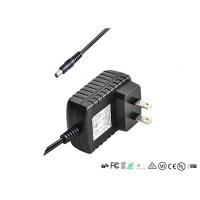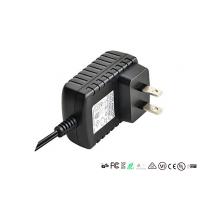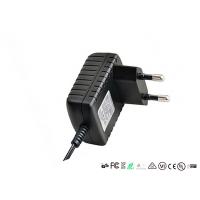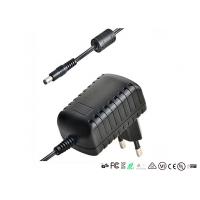- Universal AC input / full range
- 2 pole EU plug (Class II power, without earth pin)
- Medical safety approved (2xMOPP between primary and secondary)
- Suitable for BF application with appropriate system consideration
- Low leakage current <50µA
- No load power consumption <0.1W
- Energy efficiency level: Level VI
- Comply with EISA 2007/DoE and NRCan
- High operating temperature up to +60°C
- Protections: Short circuit, overload, over voltage
- Fully enclosed plastic case
- 100% full load burn-in test
- 3 year warranty
Technical data:
| Input |
| Input voltage: 90-264VAC Frequency: 47-63 Hz |
| Input current: 0.18A max. |
| Inrush current max: 30A@230VAC |
| Leakage current: <50uA |
| Output |
| Output voltage: 1-12V |
| Output current: 100-2000MA 12W Max. |
| Load regulation: +/-3~5% |
| Line regulation: +/-0.5% |
| Ripple: 50-180mVp-p |
| Hold up time: 12ms at full load |
| Efficiency: 68-82% |
Temperature range: 0ºC…+50ºC
|

What is a medical power supply?
It is an energy source that has to possess properties that need to
meet the necessary standards for medical use in a hospital or
residential home. The worldwide ES/IEC/EN 60601-1 3rd Ed. standard
provides us with guidelines, which are more stringent compared to
guidelines for commercial or industrial appliances. Higher safety
standards and lower electromagnetic interference are required,
providing EMC Compliance.
Medical power supply requirements
What to consider for complying with ES/IEC/EN 60601-1 3rd Ed.?
The 3rd edition of IEC 60601 focuses on the safety of operating
personnel and patients. To assess medical electrical equipment, a
new classification system (MOP — means of protection) has been
introduced.
MOOP (Means of Operator Protection) and MOPP (Means of Patient
Protection)
When electronic devices do not come into direct contact with the
patient and are only handled by trained operators they are
classified in category MOOP, which means they typically only need
to meet 60950-1 and 62368-1 ITE standards for Laboratory
Environment Compliance.
The product falls into category MOPP when there will be direct
physical contact between the device and the patient and then must
meet extremely stringent safety standards, especially in regards to
insulation.
To protect patients against electric shock, such products must
feature two separate insulation barriers. The closer the contact
between the device and the patient, the lower the permissible
leakage current. Application devices are therefore classified
according to the type of contact to the patient.
Low leakage currents
We all know that electric currents through the body are extremely
dangerous and often result in death. For a healthy person, currents
as low as 40mA could be fatal. For a person who is anaesthetised or
weakened by an illness, this threshold is likely to be much lower.
To protect patients, power supplies for medical devices must meet
stringent requirements in regards to leakage and stray currents.
The limit values vary depending on the type and nature of the
applied part (AP) that is brought into direct contact with the
patient's body.
Classification of patient environment
Although the power supply meets both leakage-current and isolation,
the ended system is still required to further evaluate and confirm
the compliance with the patient environment.
Type B (Body)
No direct physical contact with patient. Examples: LED lighting in
operating theatres, medical laser units, etc.
Type BF (Body Float)
Physical contact with patient, or risk to patient from device
failure. Examples: Incubators, ultrasonic devices, diagnostic
equipment, etc.
Type CF (Cardiac Float)
Direct contact to patient's heart, risk of injury or death in the
event of device failure. Examples: Defibrillators, heart-lung
machines, etc.
Power supplies for BF & CF applications
Medical power supplies for type BF & CF medical devices are
designed to provide 2 x MOPP of input to output isolation.
EMC standard and limits
When it comes to life-supporting or life-saving devices, faults and
malfunctions caused by electromagnetic or radio interference could
obviously be fatal. The failure criteria of the IEC60601-1-2 in
regards to electromagnetic interference and electromagnetic
immunity must be taken into account in the risk management.
The 4th edition of the IEC standard on EMC stipulates much more
stringent requirements as regards electromagnetic immunity than its
ancestor. Equipment must now be immune to HF fields up to 2.7GHz,
an increase by 0.2GHz. In addition, the standard wants to prevent
damage caused by electrostatic discharge, and the relevant limits
have been increased accordingly. For contact discharge, the
threshold went up from 6 to 8kV. For air discharge, it has been
increased from 8 to 15kV.
Products
In order to meet the above requirements, in particular in regards
to insulation and leakage currents, a combination of high-quality
medical-grade AC/DC power supplies and DC/DC converters is often
the most efficient solution. This approach makes it easier to meet
the stringent requirements of double patient protection (2 x MOPP).
We offer a broad range of products that are certified for use in
medical electrical equipment. Apart from DC/DC converters from 1 to
30W, we also manufacture AC/DC power supplies with up to 150W. They
are certified to EN/ES 60601-1 3rd edition, EN/UL 60950-1 and EN/UL
62368-1, and do not contain any hazardous substances according to
the RoHS2 and REACH Directives. Another plus is the 5-year warranty
that we grant on all these products.










